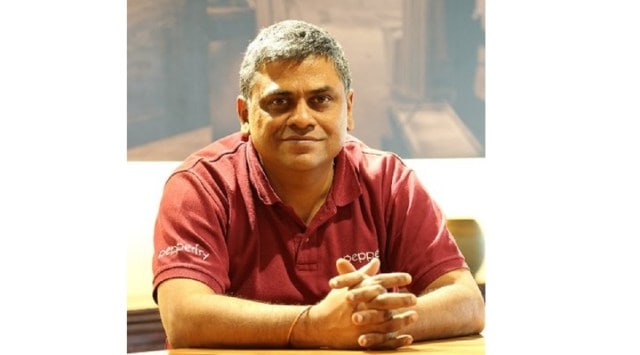Pepperfry co-founder Ambareesh Murthy dies in Leh: What triggers cardiac arrest at high altitude?
Post-40s, most Indians seldom do a heart test to understand what condition it is in and whether it can adapt to unaccustomed physical activity or stress of any kind. An analysis of underlying heart conditions is very necessary before you attempt something that your body is not used to, say top cardiologists
 Pepperfry co-founder Ambareesh Murty passed away due to cardiac arrest in Leh. (Photo: Twitter/@AmbareeshMurty)
Pepperfry co-founder Ambareesh Murty passed away due to cardiac arrest in Leh. (Photo: Twitter/@AmbareeshMurty) The death of Pepperfry co-founder Ambareesh Murthy after a sudden cardiac arrest (SCA) raises questions about its increasing occurrence even among fit people as he himself was known to be a tested biker, who had gone all the way up to Leh before. Why then are active young Indians falling prey to cardiac arrest? “That’s because post 40s we seldom do a heart test to understand what condition it is in and whether it can adapt to unaccustomed physical activity or stress of any kind. Low ambient oxygen in hostile terrain can be a trigger for sudden cardiac arrest in anybody with a pre-existing heart disease or underlying condition. We don’t know of his heart health except that he was a biker. This risk goes up in vulnerable people when you are taking a direct flight to Leh instead of taking a road. Sometimes High Altitude Pulmonary Edema, when blood vessels in the lungs squeeze together, causing fluid to leak into air sacs, can trigger hypoxia (low oxygen saturation) in the blood and even sudden cardiac arrest. That’s why we advise people to start a course of diuretic called Diamox at least a week before the intended journey so that it reduces the fluid in the body and protects you from edema,” says Dr Nishith Chandra, Principal Director, Interventional Cardiology, Fortis Escorts Heart Institute, Delhi.
On the fact that Murthy was an avid cross-country biker and trekker, Dr Chandra highlights how engaging in extreme sports without the knowledge of underlying conditions can be damaging. “Engaging in endurance sports can increase the risk of sudden cardiac arrest due to the intense physical exertion and potential stress on the heart. There are studies that show how professional cycling can change or damage the heart. In 2012, Dr James O’Keefe published a study in the American medical journal, Mayo Clinic Proceedings. showing how endurance sports led to a permanent overstretching of the heart muscle, putting an excessive strain on the heart. With just 40 marathon runners, triathletes and cyclists, involved in the study, the sample size was quite limited. However, scarring was detected in the right chamber of the hearts of five athletes. The extremely athletic subjects studied were even more likely to develop coronary artery calcification than those who had engaged in no physical activity over the years. It’s, therefore, important to undergo thorough medical evaluations and follow safety guidelines to minimise these risks,” he adds.
WHAT IS A SUDDEN CARDIAC ARREST AND HOW IS IT DIFFERENT FROM A HEART ATTACK?
“A sudden cardiac arrest is described as a condition where the heart stops abruptly and loses all its activity due to an irregular heart rhythm or electrical impulse. This irregularity sends the heart into a panic mode and its ventricles or lower chambers quiver and contract in an uncoordinated manner. So, the heart cannot pump oxygenated blood that your body needs. In the first few minutes, the blood flow to the brain is affected and the patient loses consciousness. And within eight minutes, all major organs shut down in the absence of a blood flow unless the patient is attended to,” says Dr Balbir Singh, Chairman, Cardiac Sciences, Cardiology, Cardiac, Electrophysiology-Pacemaker, Max Hospital, Saket.
A sudden cardiac arrest isn’t the same as a heart attack. “A heart attack is caused by blockages or plaque deposits and clotting in arteries which restrict blood flow to the blocked parts of the heart, causing muscle scarring. A sudden cardiac arrest is not caused by a blockage. However, if the heart attack can change the heart’s electrical impulses and cause irregular heartbeats, then it could become a trigger for a sudden cardiac arrest. A heart attack is quickly identifiable with ECG changes. But a sudden cardiac arrest doesn’t give you that time at all,” adds Dr Singh.
WHAT TRIGGERS SUDDEN CARDIAC ARREST IN NORMAL PEOPLE?
STRESS: Most data available in scientific reviews till now show that sudden cardiac arrests among the young are the result of a genetic condition called Hypertrophic Cardiomyopathy (HCM), a rare genetic disorder. This condition ends up thickening the heart muscle and is usually caused by abnormal genes. The thickened heart muscle stiffens up and cannot pump the required amount of oxygenated blood with each heartbeat. This causes arrhythmia or irregular heartbeats. “Such people are not even aware that they have a unique condition and may only feel symptoms with exercise or exertion, which in turn lead to abnormal heart rhythms. Sometimes intense emotional or physical stress can lead to rapid and severe cardiac dysfunction even when you do not have obstructive coronary artery disease or even have just 30 per cent plaques. Stress impacts cardiac ion channels, which control the heart’s electrical properties, directly. This may lead to ventricular fibrillation, arrhythmia or irregular heartbeats and trigger a sudden cardiac arrest,” says Dr Subhash Chandra, Chairman, Cardiology, BLK-Max Super Speciality Hospital.
OTHER CONDITIONS: Sometimes, other electrolyte channel-related genetic conditions, too, make the heart vulnerable to abnormal rhythms. “These are unidentified until the event when they usually develop extreme fatigue and lose consciousness, collapsing then and there,” he adds. A heart valve disease, where leaking and narrowing valves can lead to stretching or thickening of the heart muscle, can put the patient at an increased risk of developing a heart rhythm problem.
ENDOTHELIAL DYSFUNCTION: This is a type of non-obstructive coronary artery disease (CAD). “What happens is that though there are no arterial blockages as such, the blood vessels of the heart narrow down instead of dilating. This again increases vulnerability to abnormal heart rhythms leading to sudden cardiac arrest,” says Dr Singh.
GENETIC SYNDROMES: “Long QT syndrome is a heart signalling disorder that’s usually inherited and can cause fast, chaotic heartbeats. Similarly, Brugada syndrome can cause irregular heart rhythms in the lower chambers of the heart. People living with these syndromes are always at risk,” says Dr Nishith Chandra.
VIRAL INFECTIONS: These cause myocarditis, leading to scarred heart tissue that interferes with heart rhythm. “The sustained abnormal electrical activity within the heart leads to abnormal rhythms. Asymptomatic or silent viral infection, apparently trivial, can have myocardial or heart muscle involvement, triggering episodes of irregular rhythm and sudden cardiac arrest,” he adds.
HOW TO PREVENT SUDDEN CARDIAC ARRESTS?
“People often ask about red flags and I keep on repeating that they are still very much the same as for all heart conditions. This means check your blood sugar levels, keep your blood pressure and bad cholesterol or low-density lipoprotein (LDL) levels low. Sometimes your HbA1c (average blood sugar levels) may seem normal, but you may already have prediabetes. Arrest it before it spirals. Then there is a family history that we should consider. And in Indians, heart disease symptoms show up at least 10 years earlier than other populations. So, it is imperative that we track these parameters from mid-30s onwards,” says Dr Subhash Chandra.
Then there are stress tests like TMT, ECG and echocardiogram, “all of which can be done in an out-patient set-up and are enough to stratify and diagnose at-risk patients of 40 years of age,” says Dr Nishith Chandra. However, Dr Subhash Chandra feels that if somebody post-50s is attempting a very extreme and heavy endurance exercise or activity, he should do a coronary angiography to check the status of the heart. And to avoid emergencies, Dr Singh is all for installing automated external defibrillators in public places. “An AED may save your life during a cardiac arrest, so the device should be there in every gym, with the trainer instructed on how to use it. In fact, we should install AEDs in public places, malls and even housing societies for saving lives during an emergency,” he suggests.
Aug 14: Latest News
- 01
- 02
- 03
- 04
- 05
































